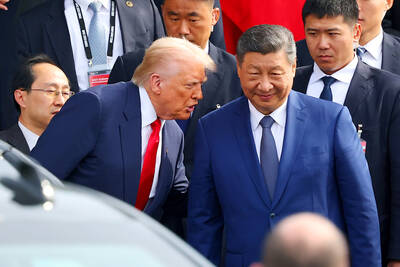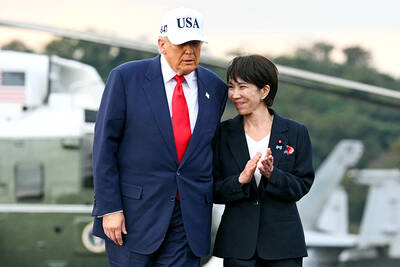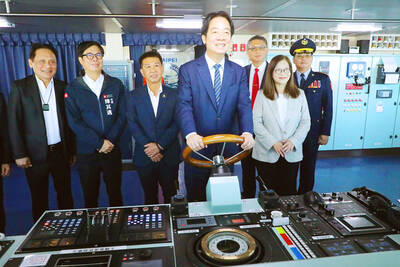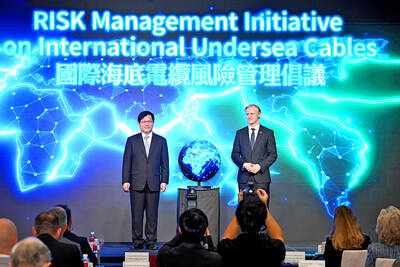Beijing yesterday warned that it would “firmly oppose” infringement of its sovereignty after indications Washington will soon send warships close to its artificial islands in the South China Sea.
Tensions have mounted since China transformed reefs in the area — also claimed by Taiwan, Malaysia, Philippines, Vietnam and Brunei — into small islands capable of supporting military facilities, a move that the US says threatens freedom of navigation.
Senior officials in Washington have signaled that the US military could sail close by the islands in the coming days or weeks to demonstrate that Washington does not recognize a Chinese claim to territorial waters around them.
Chinese Ministry of Foreign Affairs spokeswoman Hua Chunying (華春瑩) said that the country respected freedom of navigation and overflight in the South China Sea, but would “firmly oppose infringement of sovereignty under that pretext.”
Beijing insists it has sovereign rights to nearly all of the South China Sea, even waters close to the coasts of other states.
The sea is a strategically vital waterway with shipping lanes through which about one-third of all the world’s traded oil passes, and the dispute has raised fears of clashes.
An editorial in the Global Times, which is close to the Chinese Communist Party, condemned Washington’s “ceaseless provocations and coercion.”
“China mustn’t tolerate rampant US violations of China’s adjacent waters and the skies over those expanding islands,” it said, adding that its military should “be ready to launch countermeasures according to Washington’s level of provocation.”
Coming within 12 nautical miles (22km) of the islands could be a “breach of China’s bottom line,” the paper said, adding: “If the US encroaches on China’s core interests, the Chinese military will stand up and use force to stop it.”
Satellite images of the islands published by the Washington-based Center for Strategic and International Studies show that China has reclaimed millions of square meters of land in the Spratly Islands (Nansha Islands, 南沙群島).
The imagery also shows China has built a host of facilities, including as many as three runways, at least one of them 3,000m long.
On Saturday, China said work had finished on two lighthouses in the disputed area and pledged more construction, which it says is intended to serve civilian, as well as military purposes.
The work has been seen as an attempt by Beijing to assert its territorial claims by establishing physical facts in the water, although international law says they can only arise from naturally occurring geographic features.
In May, video taken by CNN during a surveillance flight by a US P-8 Poseidon showed Chinese naval forces warning the US aircraft away from the artificial islands.
A tense broadcast from Chinese forces in the area, warned the craft, which remained outside the limit, to “please go away ... to avoid misunderstanding.”

UKRAINE, NVIDIA: The US leader said the subject of Russia’s war had come up ‘very strongly,’ while Jenson Huang was hoping that the conversation was good Chinese President Xi Jinping (習近平) and US President Donald Trump had differing takes following their meeting in Busan, South Korea, yesterday. Xi said that the two sides should complete follow-up work as soon as possible to deliver tangible results that would provide “peace of mind” to China, the US and the rest of the world, while Trump hailed the “great success” of the talks. The two discussed trade, including a deal to reduce tariffs slapped on China for its role in the fentanyl trade, as well as cooperation in ending the war in Ukraine, among other issues, but they did not mention

Japanese Prime Minister Sanae Takaichi yesterday lavished US President Donald Trump with praise and vows of a “golden age” of ties on his visit to Tokyo, before inking a deal with Washington aimed at securing critical minerals. Takaichi — Japan’s first female prime minister — pulled out all the stops for Trump in her opening test on the international stage and even announced that she would nominate him for a Nobel Peace Prize, the White House said. Trump has become increasingly focused on the Nobel since his return to power in January and claims to have ended several conflicts around the world,

CALL FOR SUPPORT: President William Lai called on lawmakers across party lines to ensure the livelihood of Taiwanese and that national security is protected President William Lai (賴清德) yesterday called for bipartisan support for Taiwan’s investment in self-defense capabilities at the christening and launch of two coast guard vessels at CSBC Corp, Taiwan’s (台灣國際造船) shipyard in Kaohsiung. The Taipei (台北) is the fourth and final ship of the Chiayi-class offshore patrol vessels, and the Siraya (西拉雅) is the Coast Guard Administration’s (CGA) first-ever ocean patrol vessel, the government said. The Taipei is the fourth and final ship of the Chiayi-class offshore patrol vessels with a displacement of about 4,000 tonnes, Lai said. This ship class was ordered as a result of former president Tsai Ing-wen’s (蔡英文) 2018

GLOBAL PROJECT: Underseas cables ‘are the nervous system of democratic connectivity,’ which is under stress, Member of the European Parliament Rihards Kols said The government yesterday launched an initiative to promote global cooperation on improved security of undersea cables, following reported disruptions of such cables near Taiwan and around the world. The Management Initiative on International Undersea Cables aims to “bring together stakeholders, align standards, promote best practices and turn shared concerns into beneficial cooperation,” Minister of Foreign Affairs Lin Chia-lung (林佳龍) said at a seminar in Taipei. The project would be known as “RISK,” an acronym for risk mitigation, information sharing, systemic reform and knowledge building, he said at the seminar, titled “Taiwan-Europe Subsea Cable Security Cooperation Forum.” Taiwan sits at a vital junction on